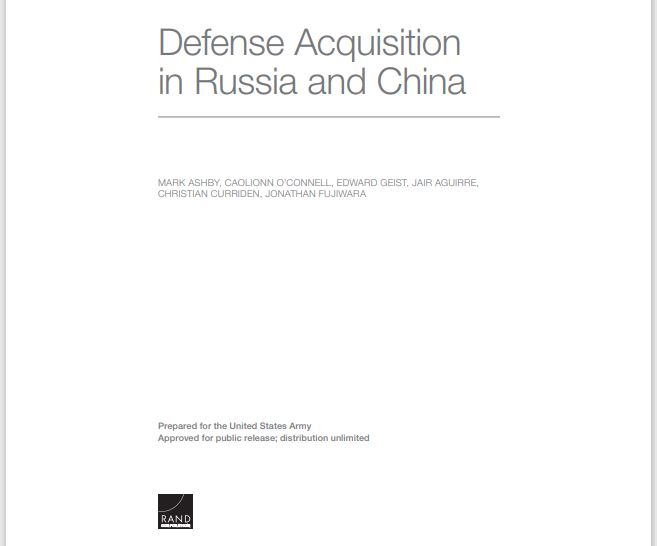Defense Acquisition in Russia and China
Mark Ashby, Caolionn O'Connell, Edward Geist, Jair Aguirre, Christian Curriden, Jon Fujiwara

Since the 70s and 80s, U.S. defense acquisition has focused on sophisticated technologies, such as precision-guided weapons and stealth. Meanwhile, Russia and China have sought to modernize their legacy equipment while concurrently developing new and increasingly sophisticated systems of their own. This report discusses recent research into the research, development, and acquisition (RDA) processes of Russia and China—both doctrinally and in practice—and identifies areas in which each country excels and where each country has challenges. Assessing the current state of and future prospects for Russian and Chinese acquisitions provides valuable insight to policymakers who are responsible for ensuring that the United States maintains an advantage over these pacing threats. On paper, the RDA processes of both countries are similar to those of the United States, but that is not the whole story. Russia maintains a large arms export market but struggles to produce its most sophisticated systems in strategically significant quantities. China's reliance on intellectual property theft means its weapons are years behind, but the Chinese recognize that shortcoming and are investing in and growing their organic capabilities through joint ventures and acquisition of foreign technology.
Key Findings
Russia maintains a large arms export market but struggles to produce its most sophisticated systems in strategically significant quantities
-
Russia's State Armaments Program–2020 was successful insofar as it was adequately funded, managing to retrofit much of its legacy Soviet equipment to modern standards.
-
The next SAP's goals will be harder to accomplish because it calls for the procurement of new and highly sophisticated systems in large quantities. Complete execution of the plan is unlikely without increases in manufacturing capability, funding, and political will.
China appears to be on a path to mitigating some of its historical shortcomings in RDA execution
-
China's reliance on intellectual property theft means its weapons are years behind, but the Chinese recognize that shortcoming and are investing in and growing their organic capabilities through joint ventures and acquisition of foreign technology.
-
China's inability to manufacture highly sophisticated parts continues to limit its status as a first-rate developer and producer of state-of-the-art military materiel, but progress is apparent.
-
Successfully developing an indigenous aircraft engine and producing it in large quantities will signal a turning point in the capabilities of the Chinese defense industry.
Sourced from: https://www.rand.org/pubs/research_reports/RRA113-1.html
RAND Corporation
